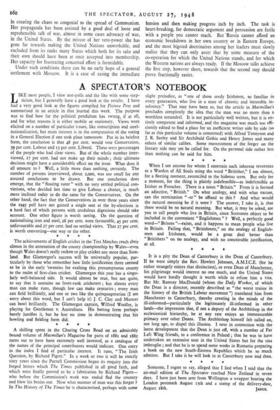A SPECTATOR 'S NOTEBOOK
LIKE most people, I view test-polls and the like with some scep- ticism, but I generally have a good look at the results. I have had a very good look at the figures compiled for Picture Post and summarised in an article in that journal this week. The purpose was to find how far the political pendulum has swung, if at all, and for what reasons it is either mobile or stationary. Views were elicited on a number of particular issues, like conscription and steel- nationalisation, but main interest is in the computation of the voting in a General Election if one took place tomorrow. Put in its briefest form, the conclusion is that 48 per cent. would vote Conservative, 39 per cent. Labour and 13 per cent. Liberal. These were percentages of the people who had clear views. But of the whole number inter- viewed, 17 per cent. had not make up their minds ; their ultimate- decision might have a considerable effect on the issue. What does it all amount to ? Well, a little more than nothing, certainly. The number of persons interviewed, about 2,000, was too small for any assured conclusions to be drawn. But one conclusion does emerge, that the " floating voter " with no very settled political con- victions, who decided last time to give Labour a chance, is much more inclined today to do the same for the Conservatives. On the other hand, the fact that the Conservatives in over three years since the 1945 poll have not gained a single seat at the by-elections is a hard fact of which persons with credulous digestions should take account. One other figure is worth noting. On the question of nationalising iron and steel, 28 per cent. were favourable, 45 per cent. unfavourable and 27 per cent. had no settled views. That 27 per cent. is worth converting—one way or the other.
* * * *


































 Previous page
Previous page